The Revillagigedos Islands are a diver’s paradise, from deep canyons and sheer pinnacles to enormous lava walls and craggy caves, this place has it all. But there is one dive site that outshines the rest, which sets the Revillas apart and assures its place in the top diving destinations in the world…
…The Boiler
From the southern anchorage on San Benedicto it’s a three-mile ride up the west side of the island to a dive site called The Boiler. The Boiler is a sheer rock pillar a mile offshore that rises straight up from 120 feet to within fifteen feet of the surface. It’s called The Boiler because it’s shallow enough that waves ball up and pitch themselves over the top of it, churning and “boiling” the sea. As a dive site it’s known for its schools of Wahoo and Yellow Fin Tuna, friendly hang-out-with-you dolphins and, most of all, for the number of giant mantas that circle it.
“The Boiler is one of the most fantastic dives you’ll ever do,” explained our friend Terry. “It’s a cleaning station so mantas just hang out and circle around and around. And they’re curious too, just as interested in us as we are in them.” Terry and Dawn on the trimaran Manta are the reason we’re out here. We met them last July in the Sea of Cortez and hit it off right away. They have been exploring and diving Mexico, Central and South America for over twenty years and have amazing stories, from ear splitting whale songs to riding giant mantas and crawling into shark-filled caves. For ten years Terry spent the winter months out here, diving and exploring the wildness of these islands. “The islands give us so much, they show us how big life can be. When you go out there you need to try to give back, if you see any fishing nets clean them up, anything you can do, even if it’s a simple thank you. It’s a one-of-a-kind place and we need to keep it that way.”
Most of the other boats at these islands are big dive boats over one hundred feet long that can anchor in deep water next to The Boiler but it’s too deep for Orion. Instead we drove Gladiator (our dinghy) up from the southern anchorage. It took a few times to feel comfortable taking an eleven-foot dinghy three miles up a jagged coastline and anchoring it on a tiny wave strewn pinnacle a mile offshore. It helped that Gladiator’s outboard motor is trustworthy (a must if you’re going to explore these islands) and that on most days one or more dive boats were within hailing distance. But when you’re in a tiny boat surrounded by over three hundred miles of open ocean it’s healthy to be a bit nervous, it’s a serious situation if the motor dies and the wind and currents are too strong to paddle against. As a precaution we always carry tools and spare spark plugs, a VHF radio, handheld GPS and sometimes we even bring our emergency satellite beacon (EPIRB). And to keep everything in the dingy if she flips, we tether it all in. When we’re this far from help we can’t have fun if we don’t feel safe.
Anchoring Gladiator on The Boiler is not our normal drop the anchor, tie it off, and check that it’s secure at the beginning of the dive. Because waves “boil” over it, this site requires a unique technique we named the Drop and Go. First, we assess the scene (sometimes for over an hour). Are waves breaking over The Boiler? If so, how often? Every minute, every five minutes, or is it random? Is there current or wind? Which way is the dinghy going to swing once anchored? Most of the time the current and wind were coming from different directions so it was important to determine which would affect Gladiator more. From this information we determine where on the pinnacle we want to drop the anchor and how quickly we’ll need to swoop in, “Drop” the anchor and “Go”. We then double check that everything is ready, wait for the right moment… wait for it… wait for it… and go. In a sweeping arch we approach the drop zone, let the anchor go, and continue the arch back out away from the pinnacle while quickly paying out 200 feet of rode (anchor line). With 200 feet between Gladiator and The Boiler breaking waves will dissipate before they have a chance to flip her over… fingers crossed. We like this method because it makes us feel safe. It allows constant forward motion while approaching and moving away from the pinnacle and we never have to go directly over the pinnacle to escape an unexpected wave. In other words, we always have a way out.
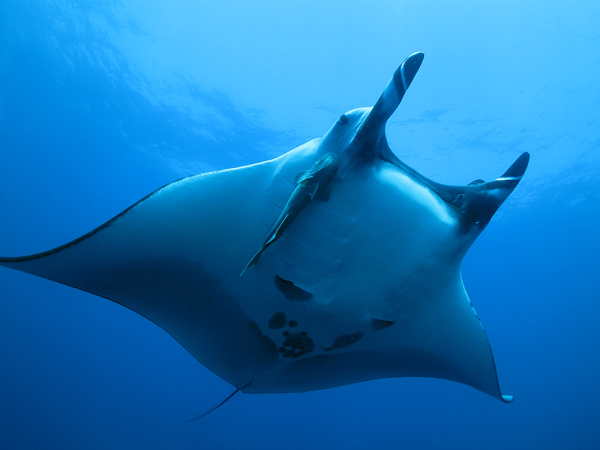
Often mantas can be distinguished by their under markings, but we didn’t have enough time to learn them by name
If waves are not breaking over The Boiler we anchor in our normal fashion. The only difference is we use less rode than normal (30 feet max). This minimizes the chance of a manta getting caught in it. Sadly, mantas do occasionally get caught people’s anchor rode. The first time we anchored on The Boiler a dive boat came over to us and explained that the mantas don’t always see the rode and sometimes it gets caught between their cephalic lobes. “They don’t swim backwards, so they can’t get untangled,” explained the biologist on the Nautilus Explorer. “Instead they do flips to try to get free, entangling themselves even more.” To help prevent entanglements they suggested attaching twelve inch pieces of line at one-foot intervals to the Gladiator’s anchor rode to make it more visible. Although we hadn’t heard or read about this issue it sounded plausible so we lifted our anchor and tied up to their boat for our dive. Once back on Orion we added the visibility lines to the rode and fortunately never caught a manta.
But others weren’t so lucky. During our last week at the islands a manta was entangled in the rode of another private boat’s dinghy while the owners were on a dive. The manta took the dinghy, anchor and all, and headed out to sea leaving three unsuspecting divers bobbing in eighty feet of water. Fortunately, another boat saw the dinghy zooming towards the horizon, recognized what was happening and was able to help retrieve the dinghy and the divers safely. But the manta wasn’t so lucky. Before it could be disentangled the rode was cut away from the dinghy and, unless the anchor and line fell off, there is a good chance the manta died.
The incident made it plain that visibility lines are necessary and we need a strategy to free a manta if one entangles itself in our rode. We talked to Rey, a dive master on one of the dive boats, and he explained that it’s important not to cut the anchor line. “You need the dinghy to act as a buoy, holding the manta at the surface so any line that is wrapped around it can be cut. It usually takes one or two people on scuba to cut the line off the manta and another person to continually bail out the dinghy. If the manta has wrapped the line around itself and you cut it away from the dinghy before it’s untangled it will likely die.” He emphasized that the best way to avoid the whole situation is to skip anchoring and “live boat”; this is when one person stays in the dinghy to drive it while the others dive. All the big dive boats use this method but with just two of us it wasn’t an option for Megan and I. Fortunately, most times we dove The Boiler we were able to tie off to one of the large dive boats and swim over.
After all that it’s time to go for a dive. The depth, size and magnificence of The Boiler are hard to describe but when all the outrageous moments are blended together this is the scene:
On The Boiler there is life everywhere. A moray eel stares out from a craggy hole, its razor filled mouth agape, a hundred pink pacific creole fish dance in the current, while spotted leather bass cruise in and out, over and around. Neon trimmed bluefin trevally and curious black jacks circle in to get a closer look, Moorish idols swoosh their trailing fins as they pick at the reef, and parrotfish, with their blue, yellow and green masks, bite off chunks of coral. A pair of white-tip sharks slip over a ledge, giant tuna pass in the distance and all the while we sway back and forth in the gentle surge.
Off in the blue appears the shadowy outline of a giant manta, her dark shape flickering in and out of filtered sunlight. Slow and soft she pulses her wings and glides this way. She is fifteen feet across and ten feet long, a living wing flying through a fluid world. Fifty feet out, twenty feet, three feet, one foot… she stalls her motion, pauses midflight. Her thick black wings sweep out and up, the tips gracefully arching to the sky. Floating eye to eye, the moment is intimate and timeless. It’s as if her eyes are a porthole into everything that is good, everything we know in our heart to be true. She is wild and free, righteous and reverent… She is soft strength in motion. She tips her wing and glides on. But it doesn’t end, there are mantas all around, they glide by one, three, ten at a time. Flying in and out of the blue, stalling and passing and circling back, over and over, their big dark eyes watching us as intently as we watch them. And when you are there on the shear wall of The Boiler swimming with these magnificent creatures, it is clear that they love the attention, the interaction, the connection just as much as we do.
It’s the saddest thing in the world to run low on air at The Boiler, to be obligated to go to the surface and face the reality that we are air-breathing, land-based creatures; to climb back into the dinghy and drive away from one of the few wild places still left in the ocean. But the relieving truth is that we came from the sea and someday we shall go back to the sea and when I do, a part of me will forever swim with the mantas of San Benedicto.
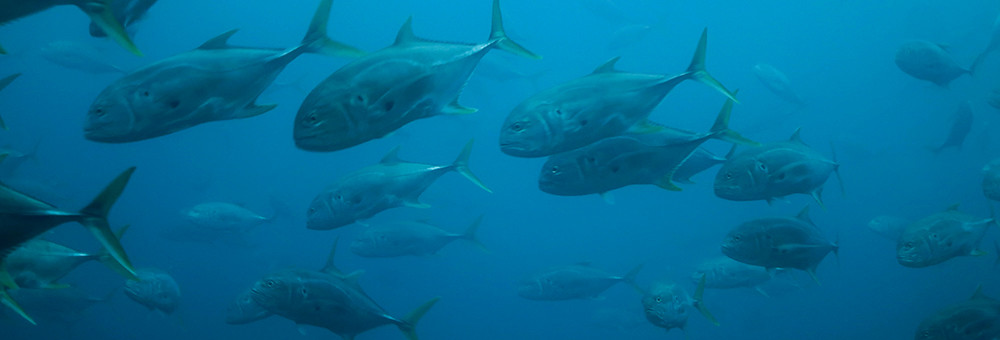
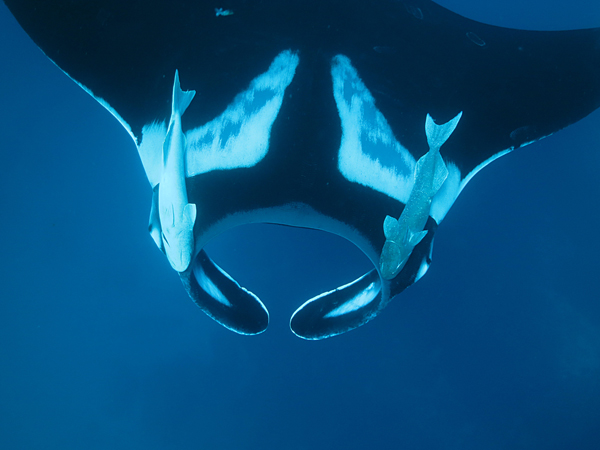
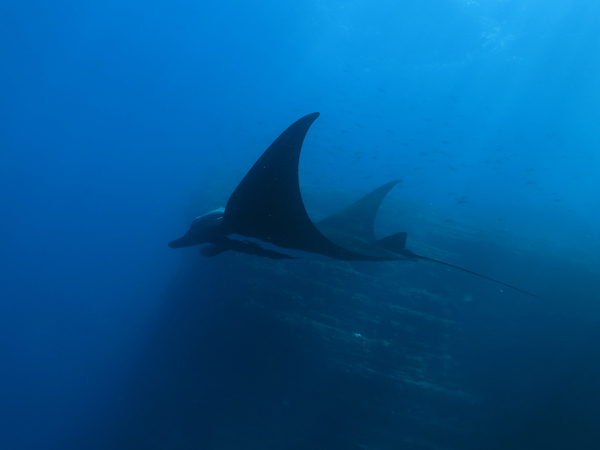
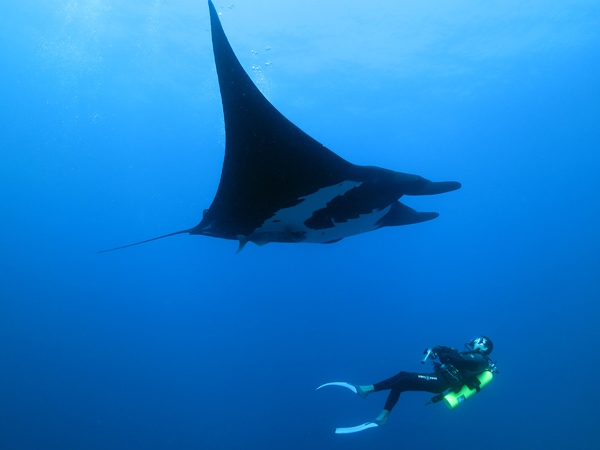
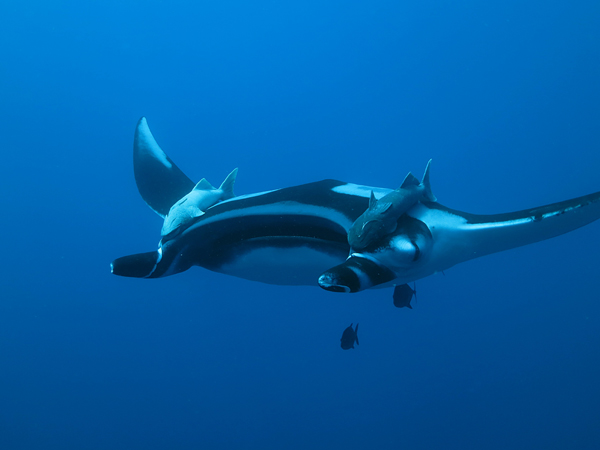
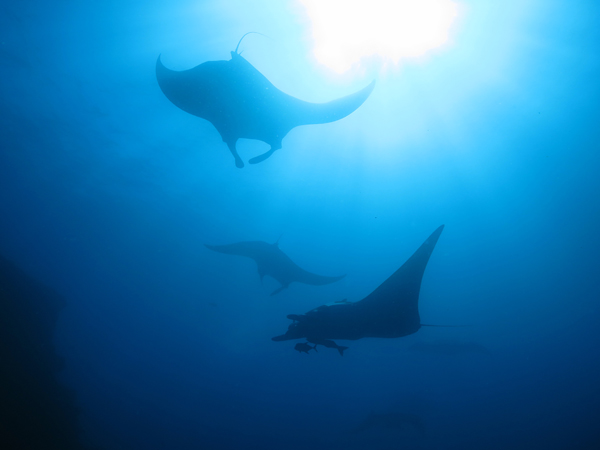
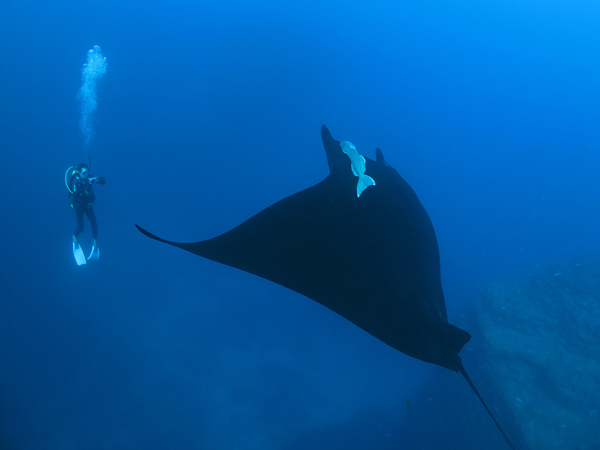
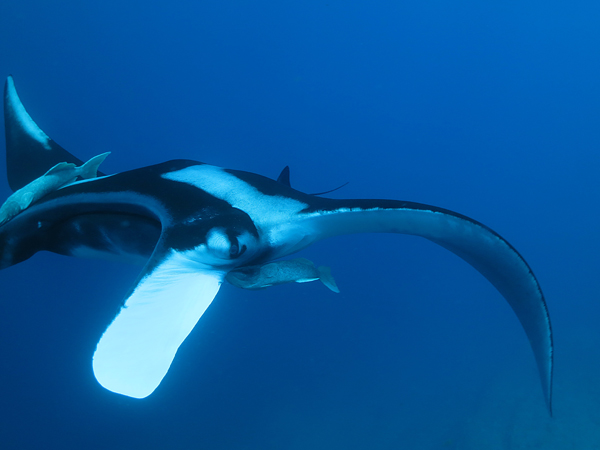
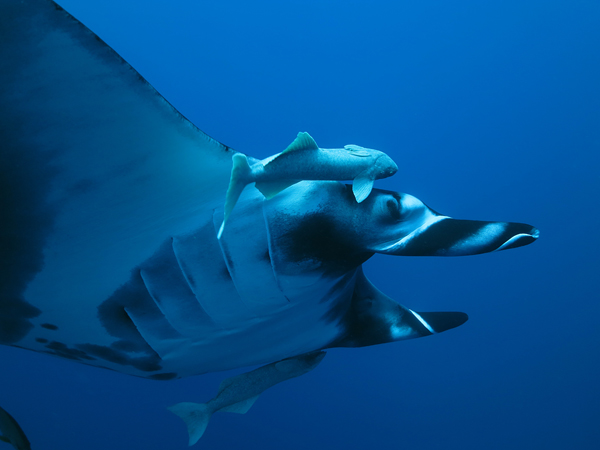
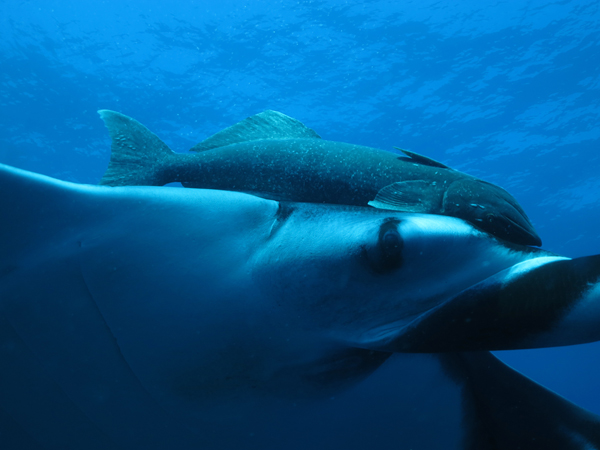





I’m the one whose dinghy anchor the manta got tangled in. Having thought a lot about this since that day, I don’t think that improving the visibility of an anchor line is enough by itself. It should be possible to manta-proof an anchor, either by using heavy all-chain rode or (more practically) by running nylon line through sections of PVC pipe so that the rode cannot articulate enough to wrap around a manta. More here: http://bhackett.org/?p=550.
FWIW I’m pretty sure the manta that got tangled in our anchor is alright; it had just one wrap of line around its cephalic lobe, and when I got to the dinghy after the anchor had been cut away there was a manta swimming around in the immediate vicinity, well away from shore. Still, I want to do what I can to keep this from happening again.
Hi Brian,
Good to hear from you. We’re glad to hear that the manta is likely ok. The whole event was eye opening for us and we too are going to do what we can to prevent it from happening to us or any other boats.
I like your thoughts on “manta proofing” a dinghy anchor. We though about using an all polypro line so the majority of the rode would float or a leaded line so it would all sink but either choice has some major draw backs and both still leave a section of line going through the water column. I like your PVC idea for most of the San Benedicto and Socorro dive sites because they are shallow (30’ to 40’). But I’m not sure how well it would work at The Boiler. Unfortunately, at The Boiler a dingy either anchors in 100′ of water or drops an anchor on the boiler and runs out 100’ to 200′ of rode (if waves are breaking). Either way having 100′ to 200′ of PVC in the dinghy with dive and safety gear would be hard. I think the best all around anchoring solution is to make the rode extremely visible. Using oversized rode and adding a ton of “visibility lines” seems like the best way to do that. If the “visibility lines” are white or yellow (these colors seem like the most high contrast colors underwater), twelve inches long, placed in pairs at six to twelve inch intervals, and are made from both polypro and nylon so that some will float and some will sink the rode should be visible even on a poor visibility day. Of course the best solution is to live-boat, which is what we hope to do when we return next year. But just in case we can’t live-boat we’ll bring some PVC and anything else we can so we have as many options as possible while we’re out there.
If you come up with any other ideas let us know and we’ll do the same.
Jonah